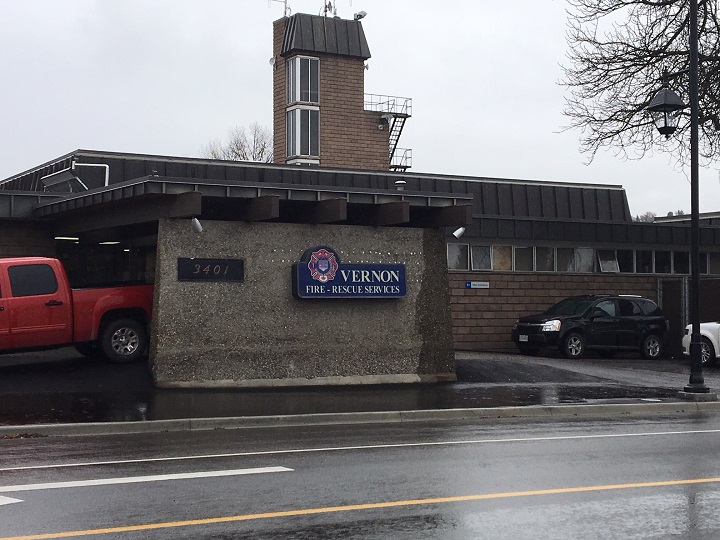Two Vernon firefighters were fired earlier this year for engaging in sexual activity in the fire chief’s office, according to an arbitration document.

Last month, an arbitration case between the City of Vernon and the Vernon Professional Firefighters Association revealed that the two were dismissed on March 26 after video surveillance caught them having, according to the union, “a deeply personal and compromising interaction.”
The arbitration centred on the surveillance video.
WATCH BELOW: May 9, 2018: A hidden camera was found in a downtown Toronto Starbucks.

In the arbitration document, the fire chief, David Lind, said he installed a surreptitious surveillance camera in his office after finding that one of his file cabinet drawers was shut but unlocked on Sept. 18, 2017. Lind said he locked the cabinet before leaving work on Friday. No document was missing and none seemed to be out of order.
The three-member arbitration panel ultimately viewed the surveillance as admissible, with chair James Dorsey and employer nominee John McKearney agreeing and union nominee Lorne West dissenting.
The arbitration document spanned 48 pages and asked many questions regarding the incident, which took place on March 25. The video time stamp was 9:25 a.m., with Lind going into his office for a brief period of time at 10 a.m.
The next day, the two were interviewed, then fired on March 27 with the union grieving the dismissals on April 4. The two employees were not named.
WATCH BELOW: In December 2017, hidden cameras were found inside some AirBnB rental properties.

The union said it did not deny that the two engaged in the activity recorded in the footage. But the union’s viewpoint was that the surveillance video broke privacy rights that employees are entitled to. And if it broke privacy rules, the surveillance video couldn’t be used in justifying the two employees’ dismissal.
“The only justification the employer had for a full-scale assault on the fundamental privacy rights of all of its employees was one unlocked cabinet, which was most likely left unlocked for innocent reasons. Without more, this reason falls significantly short of reasonable and probable cause,” the union argued.

Get breaking National news
West also said he had a “significant concern with the employer sharing and viewing the video footage or discussing the content in detail, with a wider audience than necessary.”
WATCH BELOW: In April, 2016, video footage showed a personal care worker in Georgia abusing a 69-year-old woman in a wheelchair who was unable to defend herself.

But the employer argued there would be no issue of admissibility of video footage if it was of someone making an unauthorized entry into the filing cabinet. Deciding whether to admit or exclude this video footage cannot be different “because the grievors instead chose to engage in sexual activity in front of the filing cabinet.”
Lind was technically the interim fire chief at the time when this happened. He said didn’t lock his office door, as he sought to foster a culture of openness from the beginning. Lind, though, said he was vigilant in locking his office filing cabinet. The cameras were removed on April 12, with deadbolts and keypads installed on the office doors.
In his assessment, Dorsey said “the brief, fleeting loss of privacy by individual firefighters from Dec. 8, 2017, to April 12, 2018, was at the lower end of any range of seriousness of invasion of privacy at work. The video footage was not a serious invasion of privacy for each firefighter.
WATCH BELOW: In March 2015, a Colorado EMT pleaded guilty to theft after hidden cameras captured him nabbing pain medication from a patient’s bedroom.
“On balance, our assessment of each factor and the interaction among them in this matrix of factors persuades us that this surreptitious surveillance as conducted by the employer was both a necessary collection of employee personal information for an investigation of employee misconduct and to manage the employment relationship and a reasonable exercise of management authority in all of the circumstances. It was narrowly focused surveillance based on a genuinely held suspicion with minimal invasion of employee privacy.
“Therefore, the union’s application to exclude the March 25, 2018 video footage from the admissible evidence in this arbitration over the dismissal of each of the two employees is dismissed.”
As noted above, West dissented and took aim at Lind.
“His testimony appeared scripted and rehearsed and the evidence in the form of his testimony and notes, appeared fabricated. In totality his testimony and evidence were not believable. In short, I believe he perjured himself throughout his testimony. If there is no truth to interim fire chief Lind’s testimony then there can be no justification for the video camera installation. Therefore, the video footage should not be admissible.”
West also said “In my view, it appears interim fire chief Lind fabricated evidence after the fact to support installing covert video surveillance. He did not demonstrate a truly held belief. He fabricated a story, or stories, to justify covert video surveillance.”


Comments